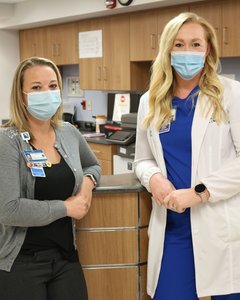A project that is helping to reduce the number of hospital-acquired pressure injuries at Sarah Bush Lincoln is gaining national recognition.
A collaborative study spearheaded by Respiratory Care Manager Lexie Caraway and Wound Care Nurse Practitioner Kaitlin Denson was recently published by the American Association for Respiratory Care after its success in reducing the number of respiratory device-related pressure injuries at SBL. Caraway is scheduled to present the study at AARC’s Virtual Open Forum in December.
The pair established a multidisciplinary team and established new prevention protocols, which included taking thermographic imaging photos of patients upon hospital admission to detect areas of the skin that are prone to developing deep tissue injuries, and then started preventive measures before any skin abnormalities appeared.
While respiratory medical device pressure injuries accounted for 27 percent of all hospital-acquired pressure injuries at SBL in fiscal year 2019, there have been no hospital-acquired injuries related to respiratory devices in fiscal year 2020.
“I’m so excited to present this to AARC. In respiratory therapy, thermal imaging is brand new. No one else is doing this!” Lexie said.
In her mission to reduce pressure injuries hospital-wide, Kaitlin credits Sarah Bush Lincoln for having the foresight to purchase a thermal imaging camera for the detection of pressure wounds. “These wound care cameras are cutting edge, and Sarah Bush Lincoln was the first hospital in Illinois to use this technology,” she said. “We have a new protocol where we take pictures upon admission, because there’s data that suggests that temperature changes happen before visual changes do in pressure injury development, so we can begin preventive treatment right away.”
Kaitlin credits Critical Care nurses Terri Gardner and Toni Lampe, and Respiratory Therapist Billee Carman for making an important discovery when they took a thermal image of a patient who was dependent on a home-use respiratory device. “We thought this would be a great project to see if our patients who are using respiratory devices at home [such at CPAP machines] are coming in with temperature changes, so we could start prevention protocols on them too,” Kaitlin said. “It’s critical to catch the sores early, because once they start, they typically progress into deeper ulcers that take a long time to heal and that have the potential to become infected.”
As part of the admission questionnaire, respiratory therapists now learn which patients are using at-home respiratory devices, so they can take baseline, thermal images of their faces. The photos are reviewed by wound care nurses and prevention measures are started at once, whether or not the patients have skin abnormalities at the time.
Additionally, “whenever patients are started on BiPap or non-invasive ventilation, we now apply skin prep and add some extra padding underneath their devices,” Lexie said. “Skin care was not one of our top concerns, but now it is. As soon as Kaitlin made us aware of the issue, we started looking at different products to help prevent wounds. The respiratory therapy department is excited about being part of the solution.”

